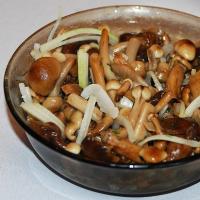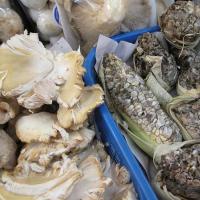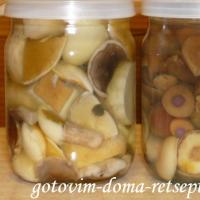Mushroom pale grebe
Many mushroom pickers and other people know such a mushroom as pale grebe. This is a poisonous plant that belongs to the fly agaric family. It is inconspicuous in appearance, but it must be avoided, as it can lead to the death of a person. After studying the material from the article, it will be possible to find out what a pale grebe looks like and what are its characteristics.
External features
Visually, such a plant looks like an ordinary mushroom, the shape of its body at a young age resembles an egg, and the mushroom itself is completely covered with a film. The size of his hat is from 5 to 15 cm in diameter. The color is often olive or grey, but may have greenish tints. Initially, the hat at the beginning of the plant's growth will be egg-shaped, but as it ages, it becomes flat. The edges of the cap are smooth, and its surface is fibrous. The photo shows young pale grebes.
The pale grebe has a fleshy body, its flesh is completely white in color, and if the plant is damaged, the color will not change and remains white. As for taste and smell, they are practically non-existent. On the back of the cap there are plates that are soft in structure and also white.
The leg has a different length and ranges from 8 to 16 cm, while it will be up to 2.5 cm in diameter. The leg has a thickening of the walls at the base, and it itself has the shape of a cylinder. Often its color is the same as that of the hat, but it is possible that it is completely white. Often there are moire patterns on the legs. In a young pale grebe, the leg is covered with a wide velvet ring, which begins to disappear with growth.
The plant has characteristic changes that come with age. Thus, the color of the cap changes as it grows and goes from white to gray with a green tint. The caps of an old mushroom are often gray and have a characteristic smell that is unpleasant, unlike an edible mushroom. In the photo, a pale grebe is shot down by a mushroom picker, where you can see its color and external data.

Similarities to other mushrooms
Pale grebe mushrooms are often confused with other types of edible plants, such as various russula. Mushroom pickers who do not have enough experience often cut toadstools instead of green russula, and the pale toadstool mushroom is also similar to champignons and greenfinches.
It must be remembered that champignons do not have Volvo, and as the plant grows, the plates begin to stain. To recognize russula, you need to see if there are rings on the leg and Volvo. Such plants should not have them. Russula can also be distinguished by the fragility of the pulp, they are tender enough and easily crumble in the hands. The greenfinch differs from the toadstool in its plates, which have a green tint, and also they do not have rings on the legs and volva.

Growth
After studying the description of the pale grebe, you need to know where they can grow. As a rule, such plants love deciduous forests, for example, where there is a lot of beech, oak or hazel. The soil for the growth of toadstools must be fruitful. They also like a lot of light, so if mushroom picking occurs in mixed forests or deciduous types, then you need to be vigilant.
They often grow in small groups, but single species can also be found. The growth season of such a fungus is considered to be the end of summer and all autumn. You can meet them in many regions and in many countries.

Toxicity and symptoms of poisoning
If a person eats such a product, then the body will be poisoned. The poison of the pale toadstool is not killed, even with prolonged treatment with high temperatures. If you eat 4 parts of a medium-sized mushroom, then quite severe poisoning of the body will occur. In other words, it will be enough to eat a piece of 30 grams. If a child is poisoned by such a product, then most likely the onset of death.
After poisoning, vomiting begins. It will be 1-2 days after the consumption of the product, in addition, pain in the muscles, pain in the intestines, as well as strong thirst, which cannot be quenched, begins. There may be bloody diarrhea. In some cases, jaundice develops, and the victim's liver grows in size. In case of poisoning, the patient's pulse practically disappears, the pressure decreases greatly and leads to loss of consciousness.
As a result of poisoning, the cardiovascular system fails and death occurs due to all the symptoms described. This product is very terrible, since the symptoms of poisoning are not observed immediately and appear, as a rule, on the second day after consumption. But still, the first signs can be in 6-12 hours, however, during this time the human body will already be poisoned by poisons, due to which great damage is done to a person.
If symptoms begin to appear, then you should prepare for the worst outcome. Often, treatment does not give any positive consequences. In addition, after the consumption of toadstool, a time of "false well-being" may occur. It appears on about 3 days and can last 2-3 days. As a rule, at this time there is a complete destruction of the liver and kidneys. If a person ate such a mushroom, then death occurs in a period of up to 10 days.
Why is the mushroom so dangerous and what is its chemical composition? Today, there are a couple of types of toxins that are in the plant:
- Amanitin is a poisonous slow-acting toxin with a powerful effect. It can be recognized by its characteristic purple color, which appears after using a special reagent.
- Phalloidin is a fast-acting toxin, but not poisonous enough if it enters the body itself, without additional toxins. When using reagents, it appears as a blue color.
Also in the pale grebe is amanin, which stands in the middle between a couple of the described toxins. It works quite slowly. In general, the described poisons are aimed at destroying the human liver. Once in the body, they adversely affect the biosynthesis of protein and other elements, allow the development of necrosis and thereby kill the liver.

Species close to pale grebe
There are some similar mushrooms in the pale grebe family:
- White toadstool.
- Smelly fly agaric.
- Spring fly agaric.
The smelly fly agaric also represents a lethal effect for humans. This plant is completely white with gray tones. Its hat is small in diameter, up to 11 cm. Initially, it has a conical shape, and its top is sharp, after a certain time, with growth, it becomes convex. If you take such a mushroom in your hand, it will be sticky and slimy. The leg is not more than 15 cm high, it may have a plaque similar to flakes. As a rule, the ring that is on the stem can only be found in young mushrooms; it tends to disappear quickly.
Such plants are often found in deciduous and coniferous forests. The soil for their germination must be moist. The fungus is no less common in mountainous areas. It grows actively from mid-summer to October. Mushroom pickers with little experience may confuse it with champignon. As a result, after consumption, poisoning of a complex form occurs, which leads to death. Symptoms are similar to pale grebe.
Spring fly agaric also often leads to death. Its hat is broad, smooth and saucer-like. As a rule, the hat shines in the sun. In young mushrooms, it looks more like a ball, white. Over time, the color of the plant changes to beige. In length, they grow up to 12 cm, while their leg is no more than 3 cm in diameter. Mushrooms can be found in spring. They prefer southern latitudes. Often they are classified as a subspecies of the pale grebe.
Spring fly agaric at a young age is very similar to champignon, so poisoning with them is a frequent case. There are many poisons in the fetus, which even in small dosages lead to death. If such a plant falls into a container or basket with other forest products, then everything collected will need to be thrown away, because upon contact with other mushrooms, toxins fall on them and they can kill a person.

The benefits and harms of pale grebe
No matter how surprising it may sound, such a dangerous plant can bring certain benefits:
- In small doses, the plant can be taken, this will protect yourself from poisoning by various dangerous mushrooms.
- Based on the poison, insect repellent preparations are made.
- Vaccines with plant toxins are used to rejuvenate the skin.
- Scientists have conducted studies on mice that show that the fungus is able to cope and cure cancer, but experiments have not yet been made on humans.
But, despite some benefits, the product has more harm. In this regard, it is better to refuse traditional medicine using such an ingredient, otherwise death. You need to remember the truth when picking mushrooms - if you're not sure, don't take it.



